Jane Freilicher, the Water Mill and New York City painter who broke ranks with the Abstract Expressionists in the 1950s to focus on color and light saturated landscapes and still lifes, died at her apartment in Manhattan on December 9, 2014.
Freilicher, who was an integral part of the New York School circle of poets and artists and a notable and revered figure for many years in the art world of Long Island’s East End, turned 90 on November 29, 2014. A Birthday celebration planned for December 12 at the Poetry Project at St. Mark’s Church on 10th Street went on as a celebration of her life and career as a "painter among poets" instead. Freilicher originally had planned to attend.
.
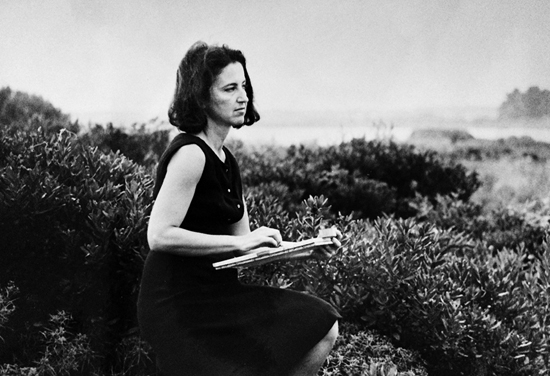
Jane Freilicher. Image courtesy Tibor de Nagy Gallery.
.
Reaction to the painter’s death in the media, from institutions, and at the personal level was swift and heartfelt.
Eric Brown, co-owner of the Tibor de Nagy Gallery in Manhattan, which represented her, wrote in the email announcing that she had died: “An extraordinary artist and an exceptional friend, Jane will be profoundly missed. We will never forget her wit, her acute intelligence, her integrity and grace.”
.
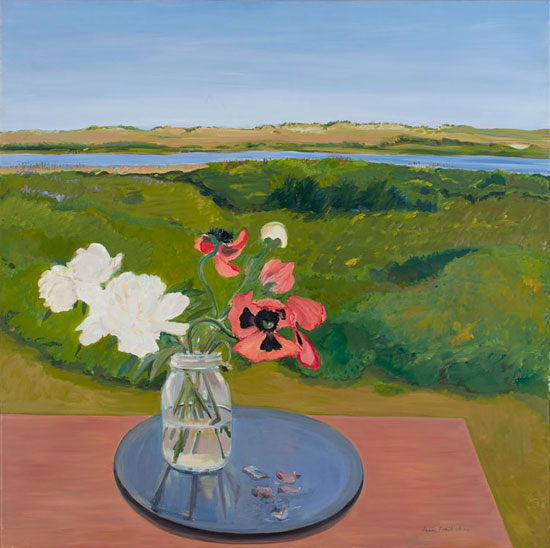
"Poppies and Peonies" by Jane Freilicher, 1981. Oil on linen, 36 x 36 inches. Image Courtesy Tibor de Nagy Gallery, New York.
.
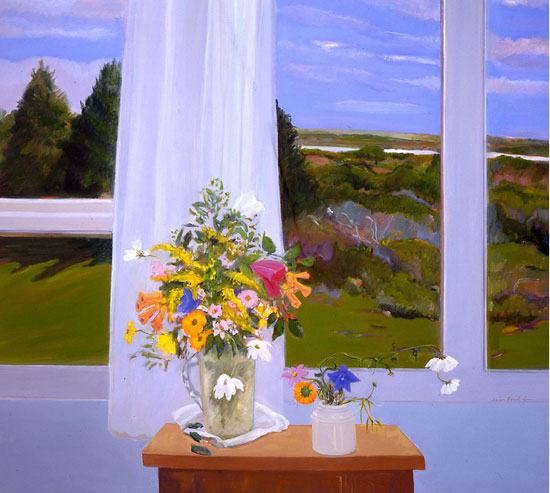
"The Sun Breaks Through" by Jane Freilicher, 1991. Oil on canvas, 47 x 49 ½ inches. Image Courtesy Tibor de Nagy Gallery, New York.
.
Brown included in the same email this excerpt from “To Jane, and in imitation of Coleridge,” a poem by Freilicher’s close friend Frank O’Hara:
“she half incloses worlds in her eyes,
she moves as the wind is said to blow,
she watches motions of the skies
As if she were everywhere to go.”
Alicia Longwell, the Lewis B. and Dorothy Cullman Chief Curator, Art and Education at the Parrish Art Museum in Water Mill, wrote in an email: “Jane Freilicher was an artist of immense vision. I always admired her forthrightness—in wit as well as in paint. She will be tremendously missed, especially here on the East End where she spent the better part of a half century engaged in astute observation and the lyrical transcription of that scrutiny to paper and canvas.”
.

"Bottles of Linseed Oil" by Jane Freilicher, 1967. Oil on canvas, 20 1/8 x 24 1/8 inches. Parrish Art Museum, Gift of Larry Rivers.
.

The Lace Tablecloth by Jane Freilicher, 1972. Oil on canvas, 50 x 60 1/8 inches. Parrish Art Museum, Gift of Eugenia Doll.
.
Director and Chief Curator at Guild Hall Museum in East Hampton Christina Mossaides Strassfield wrote in an email: “Guild Hall owns several works by Jane; we most recently exhibited it last year when we featured works from the permanent collection at Sotheby's,” as part of the annual Guild Hall Academy of the Arts dinner.
“She was the winner of the Guild Hall Lifetime Achievement Award in the visual arts and was a truly amazing artist,” Mossaides Strassfield continued. “She achieved great success at a time when women were not given their due. I curated a three-person exhibition of her landscapes and works by Jane Wilson and April Gornik several years ago that was so well received by the public and the critics. She will be missed but will live on through her work.”
.
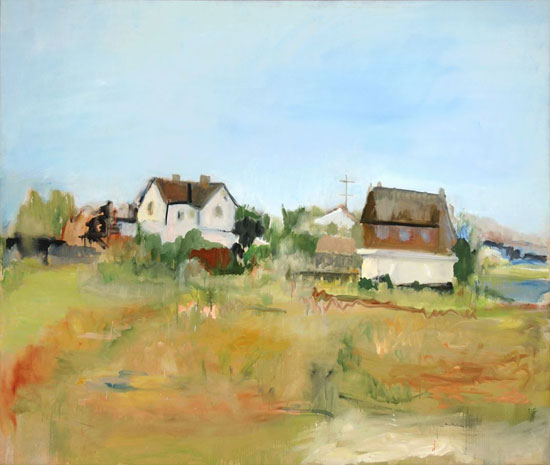
"Water Mill landscape" by Jane Freilicher, 1963. Oil on canvas, 70 x 80 inches. Guild Hall Permanent Collection, Gift of the artist.
.
Born Jane Niederhoffer on November 29, 1924, in Brooklyn, she grew up in Brighton Beach. According to an obituary by William Grimes in The New York Times published on December 10, she was just 17 when she eloped with Jack Freilicher, a jazz pianist who played with the Army band at West Point during World War II. Through her husband she met another musician, Larry Rivers, whom she influenced to become a painter and with whom, after her marriage was annulled in 1946, she had a romantic relationship.
She earned her bachelor’s degree from Brooklyn College in 1947 and a master’s from Teachers College at Columbia University in 1948.
In an obituary posted to ARTnews on December 12, Andrew Russeth wrote that when Freilicher broke up with Rivers, he slit his wrists. Rivers would later write in his memoir that “she has more integrity than anyone I have ever known.”
In 1957, Freilicher married Joe Hazan, a businessman, former dancer and Sunday painter. After the couple built a house in Water Mill, Grimes wrote in the Times obituary, her painting life alternated between winters in Manhattan, where she rendered cityscapes and interiors, and summers on Long Island, specifically the marshes and fields around Mecox Bay, “whose light and flat expanses she captured with such immediacy.”
She frequently combined still life and landscape, rendering simultaneously interior and exterior views. A table with plants in small containers is the focal point of the foreground of Small 12th Street Still Life (1976); beyond it, a busy streetscape is depicted outside a divided window.
Similarly, in Window on the Marsh (1982-83), a flower-filled vase on a table in the foreground gives way to a broad view of the marshes of Mecox Bay outside picture window frames.
Hazan died in 2012 at the age of 96. Freilicher is survived by their daughter, Elizabeth Hazan, who is also an artist; a son-in-law, Stephen Hicks, and three grandchildren, Benjamin, Katharine and Lucian.
Freilicher started out as an abstract painter after studying with Hans Hofmann in the late 1940s, but turned somewhat abruptly to representational painting, Russeth wrote for ARTnews, after seeing the Museum of Modern Art’s 1948 Bonnard retrospective.
Early on, she became an important part of the circle that sprang up around such poets as Koch, John Ashbery, James Schuyler, and O’Hara, all of whom often wrote about both the woman and her work, and painters like Rivers, Grace Hartigan and others, who all admired her painting.
Her first solo show was at the Tibor de Nagy Gallery in 1952. In a review for ARTnews, Grimes wrote in the Times, the painter and critic Fairfield Porter called her work “traditional and radical,” describing her paintings as “broad and bright, considered without being fussy, thoughtful but never pedantic.”
In the Times obituary, Grimes described the painter’s forms this way: “indicated with quick strokes and minimal definition of shape. Her bright palette gave her work a vibrant, joyful quality that some critics held against her. Ms. Freilicher, it seemed, took too much pleasure in the visible world and delivered too much of it to her viewers.”
In an interview published in ARTnews in 1985, Freilicher said her paintings were “an emotional reaction to something I find beautiful in the subject, which provides the energy, the impetus to paint.”
“I’m quite willing to sacrifice fidelity to the subject to the vitality of the image,” she continued in the same interview, “a sensation of the quick, lively blur of reality as it is apprehended rather than analyzed. I like to work on that borderline — opulent beauty in a homespun environment.”
Freilicher was included in the Whitney Biennials of 1955 (the painting annual, as it was then known), 1972, and 1995, and her work is included in numerous museum collections, including the Museum of Modern Art, the Metropolitan Museum of Art, and the Whitney Museum of American Art. In 2005 the American Academy of Arts and Letters presented her with its Gold Medal in Painting. Both The Parrish Art Museum and Guild Hall hold paintings by Freilicher in their collection.
.
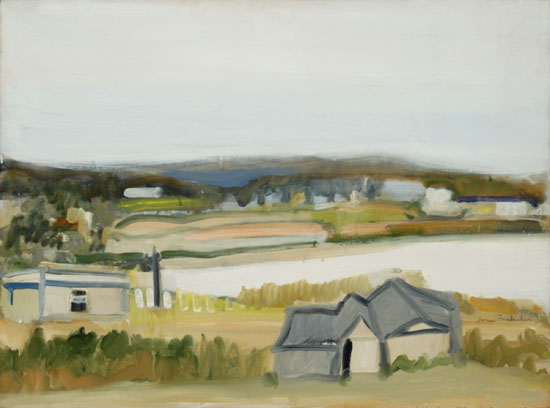
"Grey Day" by Jane Freilicher, 1963. Oil on canvas, 24 x 32 inches.
Parrish Art Museum, Gift of Larry Rivers.
.
The celebration of Freilicher's life at The Poetry Place last week was expected to draw tributes from John Ashbery, Anselm Berrigan, Adam Fitzgerald, Maxine Groffsky, Tom Healy, Alex Katz, Vincent Katz, Amy Klein, Jenni Quilter, Karen Roffman, Charles Simic, Emily Skillings, Richard Thomas and Anne Waldman, according to organizers. A planned program also included two film screenings that featured Freilicher as part of the cast.
The first was the recently rediscovered film, “Presenting Jane,” co-directed by Harrison Starr with a screenplay by James Schuyler and starring Freilicher, Frank O’Hara and John Ashbery. The second was photographer and filmmaker Rudy Burckhardt’s “Mounting Tension” which stars artist musician Larry Rivers as an obsessed artist, Jane Freilicher as his eccentric psychiatrist, and John Ashbery as a baseball jock turned abstract painter.
Freilicher also appeared in another of Burckhardt’s films, “Automotive Story” (1954), which has been described as a humorous mockumentary on cars, with Freilicher narrating the poet Kenneth Koch’s text and Frank O’Hara as the pianist. Both films are mentioned in Jenni Quilter’s essay on Freilicher, "Explicit as a Star," from the January 2014 issue of Poetry.
RELATED: NY Times: "Jane Freilicher, 90, a Lyrical Painter of Long Island Landscapes, Is Dead"
ArtNews: "Jane Freilicher, Painter and Confidant of the New York School, Dies at 90"
___________________________
Copyright 2014 Hamptons Art Hub LLC. All rights reserved.
